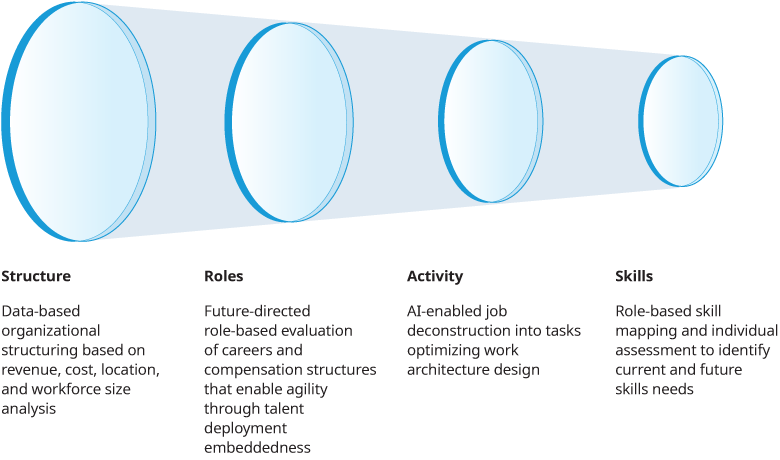In 2023, Citigroup conducted a reorganization effort that reduced its management layers from 13 to eight in what was dubbed its “biggest overhaul in decades.” The year also was marked by mass layoffs at Goldman Sachs, which let go of 3,200 employees accounting for 6.5% of its headcount, as well as Big Tech firms including Dropbox, Yahoo, and Zoom. These headline-making organizational changes share one common trait: Companies feel the need to make dramatic changes to their operating model to stay competitive in an increasingly changing market.
Part of the impetus for these moves is the companies’ desire for the skills they need to succeed. The war for talent possessing certain types of skills has been increasing and has given rise to a new market currency: the skills currency. But assuming recent conditions persist, businesses — much to their detriment — inevitably will just end up repeating what they’ve done in the past.
A round of mass layoffs today does not ensure a more efficient and adaptable future for the company. This trend also reduces morale and reduce sense of job security, particularly among critical talent whose value may be overlooked with simple headcount- or payroll-based reductions. Such moves also often neglect to consider the longer-term costs of rehiring and retraining.
The solution for organizational survival and competitiveness, therefore, lies in developing a fit-for-purpose infrastructure to attract the right talent, nurture it in an environment that provides recognition, and enable its continuous development through upskilling and reskilling for current and future needs.
A four-part framework for creating a more competitive future organization
Effective organizational transformation that embeds strategic workforce management into core operations requires a holistic methodology that captures value across the diverse pillars of structure, roles, activity, and skills.
The exhibit (below) represents the relationship between these pillars. Structure is the backbone of effective organizational design, providing the basis for role definitions and strategic career paths. Within these role definitions, organizations require a definitive understanding of “activity” (that is, what people are actually doing) and “skills” (or, the abilities people need to meet the expectations for their roles).

Observe the structure of your headcount and forecast workforce needs
Organizations undergoing restructuring often focus on reducing present-day costs through cost-out programs, without considering the long-term costs such as tacit knowledge loss, damage to the employer brand, and recruitment and training expenses.
An analysis of organizational structure must take the element of cost into account through a broader lens, exploring an organization’s global location distribution strategy, seniority mix, and peer-benchmarked organizational shape evaluation. However, cost is only one part of a larger organizational health analysis that should focus on efficiency and sustainability, examining internal governance, headcount size and mix, reporting line imbalances, and redundancies in both layers and activities. To complement this analysis, organizations can use workforce analytics that help identify gaps in skills and capabilities, as well as areas where the organization may be over- or understaffed. This involves creating models to forecast future workforce needs, which can help organizations develop strategies to address the gaps.
Design jobs that make the workforce more agile and adaptable
Effective job design plays a crucial role in individual performance by enabling the deployment of talent, which in turn ensures longer-term organizational agility. It involves creating a framework that allows individuals to utilize their skills and abilities effectively, leading to improved performance and adaptability within the organization.
A proper analysis of role frameworks takes both levels, individual and organizational, into account. The core objective of this approach is to ensure that the role framework enables an optimal structure that fits into the longer-term organizational strategy while continuing to deliver value, growth, and purpose to the individual.
On the individual level, the focus should remain on optimizing individual performance by clarifying expectations and providing incentives, implementing objective performance assessment, and fostering employees’ growth. The approach is also geared to place value on roles where it is critically needed, in order to attract top talent. Compensation analysis ensures employees are rewarded competitively while considering organizational costs.
At the organizational level, employer brand, cost implications, and operational efficiency must be considered. Organizations should develop a consistent framework that links to the full ecosystem of talent management in terms of performance, reward, and learning and development to drive a cohesive and equitable employee experience. A thorough examination of the various aspects of roles — including job descriptions, specifications, location, career progression, succession planning, development, and compensation structures — will enrich the framework. This comprehensive approach helps organizations attract high-potential talent, retain top performers, and establish a strong internal leadership pipeline.
Optimize operations to ensure sustainable business activity
Capturing the work within an organization through an operational optimization lens involves breaking down roles into tasks to assess time allocation, work nature, and potential for redeployment to artificial intelligence (AI) or agile talent pools. While cost savings are a secondary outcome, the primary value lies in long-term operational sustainability and objective performance metrics driven by clearly defined job expectations, enabling a focus on value creation.
Equip your talent with skills matching their role
The final lens in the organizational optimization framework delves into job specifications and defines skill profiles for different structural levels and job families. These profiles capture the monetary value of skills and promote role agility, enabling the organization to manage talent amidst technological and economic disruptions. The transparency from this process aids in efficient resource allocation through clear build-or-buy decisions in skills acquisition.
Optimize holistically and reduce cost-out programs to develop your organization
The end goal of organizational optimization is the delivery of holistic transformation that delivers on sustainable long-term value creation. The effort rids organizations of the recurring need to restructure in response to market changes by focusing on these pillars and setting up the infrastructure for organizational agility. This will reduce the need for traditional cost-out programs in light of a redefined approach to workforce management and organizational development.


